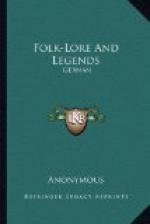The Saint was at sea during the whole night, which was stormy; and when approaching the shores of his own sacred island the following morning, a vast number of ravens were observed flying over the boat, chasing another of extraordinary large size. The croaking of the ravens awoke the Saint, who had been sleeping; and he instantly exclaimed that the son of Connal had just expired, which was afterwards ascertained to be true.
A very large Christian establishment appears to have been afterwards formed in the Bay of Cells; and the remains of a chapel, dedicated to Saint Kiaran, are still to be seen there. It is the favourite place of interment among the Catholics of this day. Indeed, Columba and many of his successors seem to have adopted the policy of engrafting their institutions on those which had formerly existed in the country. Of this there are innumerable instances, at least we observe the ruins of both still visible in many places; even in Iona we find the burying-ground of the Druids known at the present day. This practice may have had advantages at the time, but it must have been ultimately productive of many corruptions; and, in a great measure, accounts for many superstitious and absurd customs which prevailed among that people to a very recent period, and which are not yet entirely extinct. In a very ancient family in that country two round balls of coarse glass have been carefully preserved from time immemorial, and to these have been ascribed many virtues—amongst others, the cure of any extraordinary disease among cattle. The balls were immersed in cold water for three days and nights, and the water was afterwards sprinkled over all the cattle; this was expected to cure those affected, and to prevent the disease in the rest. From the names and appearance of these balls, there is no doubt that they had been symbols used by the Archdruids.
Within a short distance of the Bay of Cells there is a cave very remarkable in its appearance, and still more so from the purposes to which it has been appropriated. Saint Columba, on one of his many voyages among the Hebrides, was benighted on this rocky coast, and the mariners were alarmed for their own safety. The Saint assured them that neither he nor his crew would ever be drowned. They unexpectedly discovered a light at no great distance, and to that they directed their course. Columba’s boat consisted of a frame of osiers, which was covered with hides of leather, and it was received into a very narrow creek close to this cave. After returning thanks for their escape, the Saint and his people had great difficulty in climbing up to the cave, which is elevated considerably above sea. They at length got sight of the fire which had first attracted their attention. Several persons sat around it, and their appearance was not much calculated to please the holy man. Their aspects were fierce, and they had on the fire some flesh roasting over the coals. The Saint




